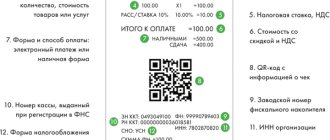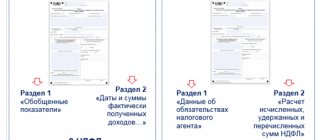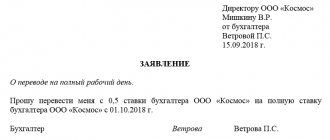Courts: deduction is possible if VAT is highlighted on the receipt
The legal position on the possibility of deducting VAT on the basis of a cash receipt was formulated by the Presidium of the Supreme Arbitration Court of the Russian Federation. In Resolution No. 17718/07 dated May 13, 2008, he considered the situation when an entrepreneur was engaged in transporting passengers by taxi and purchased fuel and lubricants for this activity at retail.
When checking the VAT return, the tax authorities asked the businessman for documents confirming the right to deduct VAT. He presented gas station cash receipts.
Since the entrepreneur did not have invoices, the tax authorities charged him additional VAT. The courts of three instances supported the tax authorities.
But the Presidium of the Supreme Arbitration Court of the Russian Federation indicated that the courts did not take into account the provisions of paragraph 7 of Art. 168 of the Tax Code of the Russian Federation that in retail the requirements for issuing invoices are considered fulfilled if the seller issues a cash receipt. The entrepreneur purchased gasoline at retail at a gas station.
Articles on the topic (click to view)
- Do you know what a trademark is and what its meaning is? Definition of concept and types, characteristics and examples
- What to do if your credit history is damaged: how to “rehabilitate” the borrower
- Classification of industrial goods
- What financial guarantee is required for a visa to Italy?
- Fedresurs bankruptcy of individuals
- How does a simplified bankruptcy procedure for a legal entity occur: procedure
- The procedure for dismissing employees in the event of bankruptcy of an enterprise, required compensation and payments
Its payment, including VAT, was made in cash, which is confirmed by cash receipts. Gasoline was used for transactions subject to VAT.
Thus, the businessman had every right to accept VAT on gasoline as a deduction. The Presidium of the Supreme Arbitration Court of the Russian Federation noted that this is consistent with the position set out in the Determination of the Constitutional Court of the Russian Federation dated October 2, 2003 No. 384-O, which explains that an invoice is not the only document for providing the taxpayer with tax deductions for VAT.
Deductions can also be provided on the basis of other documents confirming the payment of this tax.
Let us note that the above court decisions considered disputes during the period when there was no legislative requirement for the mandatory allocation of the VAT amount in the cash receipt. Now there is such a requirement.
According to paragraph 1 of Art.
4.7 of the Federal Law of May 22, 2003 No. 54-FZ “On the use of cash register equipment when making payments in the Russian Federation,” the VAT rate and amount are mandatory details of a cash receipt. Therefore, if the retailer is a VAT payer, the VAT amount will be highlighted separately in the cash receipt issued by him.
Karpova E. V. , expert of the information and reference system "Ayudar Info"
An employee of an organization that uses the traditional taxation system - an accountable person - purchases goods in a retail network (for example, office supplies, inventory, etc.). The VAT amount is highlighted in the cash register receipt attached to the advance report; There is no invoice. Does an organization have the right to claim a VAT deduction in such cases?
“Retail” VAT: the specifics of deduction of the Tax Code of the Russian Federation are not provided for
According to paragraph 2 of Art. 171 of the Tax Code of the Russian Federation, VAT amounts charged to the taxpayer upon the acquisition of goods (work, services) intended for use in taxable transactions are subject to deductions.
Expert opinion
Makarov Igor Tarasovich
Legal consultant with 8 years of experience. Specialization: criminal law. Extensive experience in document examination.
Tax deductions provided for in Art. 171 of the Tax Code of the Russian Federation for purchased goods (works, services), are carried out on the basis (clause 1 of Article 172 of the Tax Code of the Russian Federation):
invoices issued by sellers when a taxpayer purchases goods (work, services);
documents confirming payment of tax amounts withheld by tax agents;
other documents in cases provided for in clauses 3, 6 – 8 of Art. 171 Tax Code of the Russian Federation.
In this list, we are interested in other documents that are “valid” in certain (see table below) cases and give the taxpayer the right to claim VAT for deduction on purchased goods (work, services) in the absence of invoices.
VAT amounts paid to the budget in accordance with Art. 173 of the Tax Code of the Russian Federation by buyers - tax agents
VAT amounts calculated by taxpayers under clause 1 of Art. 166 of the Tax Code of the Russian Federation when performing construction and installation works for one’s own consumption related to property intended for carrying out operations subject to VAT, the cost of which is subject to inclusion in expenses (including through depreciation deductions) when calculating income tax
Amounts of VAT paid on business trip expenses (travel expenses to and from the place of business travel, including expenses for the use of bedding on trains, as well as expenses for renting residential premises) and entertainment expenses accepted for deduction when calculating corporate income tax
Amounts of VAT calculated by the taxpayer from amounts of payment, partial payment received on account of upcoming supplies of goods (work, services)
As we see, VAT amounts claimed by retailers are not included in the list. And if so, the Ministry of Finance argues, without changing its approach for years, the taxpayer has no right to claim a deduction on a cash receipt (in the absence of an invoice).
For your information: Article 170 of the Tax Code of the Russian Federation establishes that VAT amounts charged to the buyer when purchasing goods (work, services) are taken into account in the purchase price in cases the list of which is defined in clause 2 of this article.
The taxpayer's absence of documents, including invoices, confirming his right to apply a VAT deduction is not included in the specified list. Therefore, there are no grounds for including this tax in the purchase price when taxing profits in these cases.
paid by the taxpayer directly to the budget;
- paid by employees of the organization as part of travel and entertainment expenses.
Since the Tax Code does not define such for postal services, the taxpayer has the right to apply a deduction of “input” VAT on them in the generally established manner: only if there is an invoice.
Procedure for calculating VAT
When one company orders raw materials from another to produce a product, the first company pays a certain amount of money. Tax is imposed on this amount.
Later, the question of what the cost of the manufactured product will be is decided. This cost is determined by many factors. One of them is the cost of production without VAT. The amount of tax at this stage is also calculated, but it goes as a tax credit.
Then the final cost of the product is calculated at which it will be available in stores to the buyer. At this stage, the final price of the product will be formed: cost of materials + potential profit from sale + excise taxes, etc. As for the calculation of VAT, this tax also goes into the final cost. Manufacturers and sellers take it into account in the price, but the buyer pays for it.
After the goods have been sold and the company has received money, the calculation of profit begins, from which the 18% tax paid by buyers is deducted. This is approximately what the conditional VAT formula looks like. The final amount of all taxes on goods sold by a company is called the tax liability.
The courts take a different approach
The conclusion of the Presidium of the Supreme Arbitration Court is consistent with the position set forth in the Decree of the Constitutional Court of the Russian Federation dated October 2, 2003 No. 384-O, which explains that an invoice is not the only document for providing the taxpayer with tax deductions for VAT. Deductions can also be provided on the basis of other documents confirming the payment of this tax.
Judgment number
To justify the tax deductions, the company presented cash receipts with allocated VAT, issued to the company's employees when purchasing fuel and lubricants, as well as advance reports, a journal order for account 19 and purchase books. The court came to the conclusion that for a company, a properly executed cash receipt replaces an invoice and can be the basis for deducting VAT
The application of a deduction for spare parts purchased at retail based on cash register receipts with an allocated tax amount is legal
A properly executed cash receipt replaces an invoice for the purpose of confirming the right to deduct VAT
The basis for deducting VAT is an invoice and documents confirming the actual payment of tax (including a cash receipt with the amount of tax highlighted in a separate line), or a strict reporting form in which the amount of tax is indicated
Calculation of the amount excluding VAT
Now that we know the amount with tax (Kn), we can calculate K without it. Let us first recall the formula for calculating the amount with VAT - from it you can get the formula for calculating the amount without VAT.
Kn = K+M*K, where M = 18/100
Another version of the formula is also possible: Kn = K*(1+M).
From this formula it is easy to subtract the value of K we require. The formula will look like:
K = Kn/(1+M) = Kn/(1+0.18) = Kn/1.18
Now you know what VAT is and how to calculate it.
It is worth noting that working with formulas is very problematic, and to simplify the calculation there are special calculators, including online ones. With their help, you can accurately calculate the tax by simply entering the initially known parameters. This is approximately the procedure for calculating VAT.
VAT deduction on cash receipt – 2021: position of the Ministry of Finance
documents confirming the payment of customs VAT for import operations;
documents certifying payment of VAT withheld by the tax agent.
Based on the above list and referring to the absence of a separate item “cash receipt” in it, the Ministry of Finance of the Russian Federation does not consider it possible to accept VAT as a deduction on a cash receipt documenting the purchase of goods and materials in retail enterprises. Even a separate designation of the tax amount in it is not taken into account and does not give the company the right to a VAT refund.
This is what the Ministry of Finance of the Russian Federation believes: it is impossible to obtain a tax deduction for purchases that have not been formalized with invoices.
To be fair, we note that the Tax Code does not really indicate any features characterizing the conduct of VAT refund operations on goods and materials purchased at retail. Hence the conclusion of financiers about the inconsistency of the requirements for obtaining a tax deduction in the documentation under consideration.
In contrast to this statement, paragraph 7 of Art. 168 of the Tax Code of the Russian Federation explains this circumstance: when selling goods and materials for cash, the legislative requirements for the preparation of invoices are recognized as fulfilled at the moment when the buyer receives a cash receipt (or other document of proper execution, for example, BSO).
Taking into account this norm, a cash receipt can be considered as a document equivalent to an invoice, giving the purchaser-VAT payer the right to accept it for deduction.
Tax deductions
Tax deductions are the amount of payments that were presented for payment by the supplier and on which the amount of tax has already been charged. There are also rules here that businesses must follow. The amount of VAT can be deducted only if three conditions are met:
- Products that were purchased for sale were already subject to VAT.
- The received raw materials or products have undergone accounting.
- The company has all the primary documentation, and the invoice is drawn up in accordance with all the rules.
If these conditions are met by the company, then after the tax period the company can deduct the amount of VAT, but only if the products were already subject to VAT.
How are we better than our competitors?
- 1 Payment upon receipt
You pay for documents only when you receive them and fully check them - 2 We prepare invoices in a short time
Fast speed of work will allow you to reduce VAT at the right time - 3 Minimum prices
Our prices will pleasantly surprise you and help you save your money - 4 We work throughout the Russian Federation
We carry out orders from any region of the Russian Federation - 5 Round-the-clock work
We can accept orders at any time convenient for you - 6 Fast delivery
We will deliver your documents in the shortest possible time directly to your hands
Make an order
Reviews
I am a representative of a small construction company, and we often work with large organizations as a contractor. Of course, in the documents we do not reflect the actual state of things, because, like any normal people, we want to make money.
Expert opinion
Makarov Igor Tarasovich
Legal consultant with 8 years of experience. Specialization: criminal law. Extensive experience in document examination.
We have been purchasing invoices from Receipt Factory for the 2nd year now. Everything is going great! As they say, without a hitch. The guys are real professionals!
There is nothing to complain about, they worked accurately. The checks are real, the stamps on them are real, not on a printer.
Official confirmation, all details are fully written.
What is VAT on a check in simple words
As mentioned above, VAT is a tax. It’s worth starting with the fact that this tax is imposed on every service or product whose price is higher than its cost. In simple terms, interest is charged on the difference between the final price and cost. This is the concept of “added value”.
In a check, this information is often displayed as a separate line, but there is no need to be scared and think that you need to pay even more. The same 18% or 10% is included in the final amount for the product that has already been paid for.
To avoid problems with inspection, the company duplicates information according to the law. At the same time, they must have cash registers.
Regulatory acts VAT in cash receipt
Of course, any supermarket or trading enterprise must comply with legal regulations. The main regulatory act in the case of value added tax is Federal Law No. 54. He says that any enterprise must have cash register equipment. And from February 2021, equipment must be provided with the Internet in order to send checks electronically to the Federal Tax Service.
Often, regarding VAT, lawyers are asked the question: “Do I need to enter a line with the percentage separately on the cash receipt?” There are no such provisions from the legislation, but the tax service requires it. Since the situation often causes controversy, the company applies its own rules. Lawyers still advise duplicating the information in a separate phrase so that there are no difficulties with the government agency.
Who pays VAT
Having concluded, one might think that the percentage is paid by the manufacturer and this will not affect the average citizen in any way. However, it is not. Ultimately, the payment to the government comes out of the buyer's pocket. To make it easier to understand, let’s imagine an algorithm of how all this happens.
- A company orders material from a supplier for its own product. The company pays him the amount. A tax will be imposed on it.
- After its product is ready, the company makes calculations. The amount that went into production is taken into account.
- Next comes the calculation of the final price for the product. 18% is taken into account here.
- After the sale, the percentage paid by the buyer is calculated from the total profit and goes towards the tax liability.
Next, the owner of the boot store forms the final price. This includes all costs of the item and only the final amount is subject to interest.
What is VAT and who pays it?
Considering the above, we can draw the following conclusion. VAT on services and goods is paid by the manufacturer or company that provides the services. But in reality, the tax falls on the shoulders of ordinary buyers. Of course, VAT is charged to the seller, and the buyer does not submit reports to the tax office, but in fact it is he who makes the payment. One can argue with this, because legally the seller pays the tax, but in fact you do it when buying products in stores.
Calculation of the amount including VAT, example on a cash receipt
The calculation takes into account what product was purchased. Perhaps everyone has already heard about 18%; this figure applies to most products, but not to all.
If a product was purchased from the sphere of children's assortment, some food products, medicines, as well as periodicals, scientific or educational literature, then in this case the figure will change and will be 10%. There are even those products that have zero interest.
These include products exported abroad.
If you calculate the payment for medicines, for example, then it is enough to enter 10% instead of 18% into the scheme.
Reporting
One of the main points of interest to owners of various companies is reporting itself and its methods.
The required documents must be submitted once a quarter by the 25th of the next month. This matter, of course, cannot be joked with, since in case of delays fines will follow. There is a special form for filling out the report.
As a last resort, you can use postal services, for example, if you are out of town for a long time. But here, too, you should be careful and pay attention to the date that will appear on the registered letter.
This is the number that will be recorded in the report. Even if you sent a letter on June 21, and it arrived at the inspection on June 27, the date will be recorded as 21.
We suggest you figure out when it is allowed to deduct VAT, what is the opinion of the Ministry of Finance regarding the deduction of VAT on a cash receipt, and whether it is possible to deduct VAT on a cash receipt if it partially contains invoice details.
When is VAT allowed to be deducted?
In the event that an LLC or individual entrepreneur who owns a store pays VAT, the purchase amount will include the amount of value added tax.
- the company has documents indicating the existence of the right to deduct VAT;
- the purchased goods were capitalized on the company’s balance sheet;
- goods were purchased for the purpose of carrying out production activities, resale or any other operations that are subject to value added tax.
Important!
At the time of purchasing goods in a store, an invoice issued by the seller is not required. Typically, sellers issue only a sales receipt and a cash receipt.
As stated in the text of paragraph 7 of Art.
168 of the Tax Code of the Russian Federation, in the case of selling goods for cash, the requirements for issuing invoices and drawing up settlement documents are considered fully met if the buyer received a cash receipt or other document of the established form from the seller (for example, a strict reporting form). Accordingly, current tax legislation allows taxpayers to deduct VAT if:
- the product was purchased at a retail outlet;
- the seller did not issue an invoice;
- In the cash register and sales receipt, the VAT amount is highlighted as a separate line.
We analyze practical situations
In letter SD-4-3/ [email protected] dated October 23, 2018, “On the procedure for applying the VAT tax rate during the transition period,” the tax office explained how to prepare invoices, but has not yet given comments regarding the application of cash registers with the new rate. In our opinion, the following options for specifying the rate are possible:
Products purchased in 2021 were returned in 2021
If the product was sold before the new year at a rate of 18%, and the buyer decided to return it after the new year, then the receipt must indicate the rate that was in effect at the time of shipment of the goods, i.e. 18 %.
The contract was concluded in 2021, and delivery will be in 2019
The new VAT rate applies to goods shipped from January 1, 2019, and does not depend on the terms and date of the contract. This means that when selling goods in 2021, the VAT rate on the receipt should be 20%. No changes to the agreement regarding the VAT rate are required.








